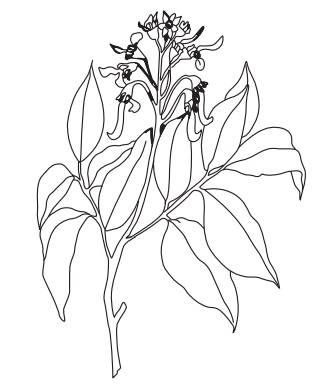Balsam Of Tolu
| Home | | Pharmacognosy |Chapter: Pharmacognosy and Phytochemistry : Drugs Containing Resins
Tolu Balsam is obtained by incision of stem of Myroxylon balsamum (L.) Harms., belonging to family Papilionaceae.
BALSAM OF TOLU
Synonyms
Tolu Balsam; Thomas balsam; opobalsam; resin tolu; balsam of
tolu; balsamum tolutanum.
Biological Source
Tolu Balsam is obtained by incision of stem of Myroxylon balsamum (L.) Harms., belonging to family Papilionaceae.
Geographical Source
The plant grows in Colombia (near lower Magdalena and Canca
rivers), West Indies, Cuba, Venezuela, and Peru. The trees are cultivated in
the West Indies.
Collection
Tolu Balsam is a pathological resin and is formed in trunk
tissues as a result of injuries. It is collected all the year except the period
of heavy rains by making V-shaped incisions in the bark and sap wood. Calabash
cups are placed to receive the flow of balsam. Many other incisions are made on
higher portion on the trees. Collected balsam is transferred into larger tin
containers and exported.
Characteristics
Tolu Balsam occurs as soft, yellowish-brown or brown,
semisolid, or plastic solid, transparent in thin layers, brittle when old,
dried or kept in cold, odour aromatic, and taste is aromatic, vanilla-like, and
slightly pungent. It is insoluble in water and petroleum ether; soluble in
alcohol, benzene, chloroform, ether, glacial acetic acid, and partially soluble
in carbon disulphide and NaOH solution. On keeping it turns to a brown, brittle
solid. It softens on warming. Under microscopical examination shows crystals of
cinnamic acid, amorphous resin and vegetable debris.

Chemical Tests
1. Alcoholic solution of Balsam Tolu (1
g) gives green colour with ferric chloride due to toluresinotannols.
2. Alcoholic solution of Balsam Tolu is
acidic to litmus paper.
3. To filtered solution of Balsam Tolu
(1 g) in water (5 ml) aqueous potassium permanganate solution is added and
heated for 5–10 min. Odour of benzaldehyde is produced due to oxidation of
cinnamic acid.
Chemical Constituents
Tolu Balsam contains resin (80%) which is a mixture of resin
alcohols combined with cinnamic and benzoic acids.
The aromatic acids are also present in free state in
proportions 8–15%. The other constituents reported in the drug are benzyl
benzoate, benzyl cinnamate, vanillin, styrene, eugenol, ferulic acid,
1,2-diphenylethane (bibenzyl), mono-and sesquiterpene hydrocarbons, alcohols,
and triterpenoids. Tolu Balsam contains 35 to 50% of total balsamic acids
calculated on the dry alcohol-soluble matter.
Uses
Balsam of Tolu is used as an expectorant, stimulant, and
antiseptic. It is an ingredient of cough mixtures and compound benzoin
tincture. It is also used as a pleasant flavouring agent in medicinal syrups,
confectionery, chewing gums, and perfumery.
Adulteration
Balsam of Tolu is mainly adulterated with colophony and
exhausted tolu balsam. In exhausted tolu balsam, the cinnamic acid is removed
previously by heating. The adulterant can be identified by heating it with
water and observing under microscope; crystals of cinnamic acid are not seen.
